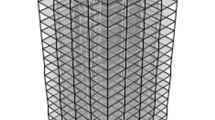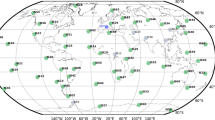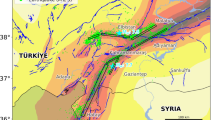Abstract
In this work, a new approach for the modeling of the interaction between grounding grid and lightning stroke is described. We treat the case of direct and indirect effects of lightning strike. In the case of direct impact, we inject in point of grounding system a current with bi-exponential wave shape and we calculate the distribution of potentials and currents on the grid and the electromagnetic field it will emit. For the second case, we treat a problem of electromagnetic coupling, which is to calculate the induced currents that developed on the grounding grid when this later is illuminated by a lightning channel located in its vicinity. The presented model is validated by comparing the obtained results to the results arising from the full wave (antenna) model available in literature and to the results obtained by using NEC4 software. The principal advantage of the presented approach is the simplicity of the implementation providing a direct determination of the both current and potential distribution along the grounding grid and the related electromagnetic field in an arbitrary point in the air and/or soil, as well.



























Similar content being viewed by others
References
Grcev LD (1996) Computer analysis of transient voltages in large grounding systems. IEEE Transactions on Power Delivery 11(2):815–823
Nekhoul B, Labie P, Zgainski FX, Meunier G, Morillon F, Bourg S (1996) Calculating the impedance of a grounding system. IEEE Transaction on Magnetics 32(3):1509–1512
Nekhoul B, Guerin C, Labie P, Meunier G, Feuillet R, Brunotte X (1995) A finite element method for calculating the electromagnetic fields generated by substation grounding systems. IEEE Transactions on Magnetics 31(3):2150–2153
Paul CR (1994) Analysis of multicondutor transmission lines. Wiley series in microwave and optical engineering, ISBN 0-471-02080-X, New York
Sullivan DM (2000) Electromagnetic simulation using the FDTD method, IEEE Press Series on RF and Microwave Technology. ISBN 0-7803-4747-1
Song J (1993) Propagation of EM pulses excited by electric dipole in a conducting medium. IEEE Transaction on Antennas and propagation 41(10):1414–1421
Sunde ED (1968) Earth conducting effects in transmission systems. N. Y. Dover Publications, New York
Liu Y, Theethayi N, Thottappillil R (2005) An engineering model for transient analysis of grounding system under lightning strikes: nonuniform transmission-line approach. IEEE Transaction on Power Delivery 20(2):722–730
Nekhoul B, Feuillet R, Sabonnadiaière JC (1996) Prediction of transient electromagnetic environment in power networks. IEEE Transaction on Magnetic 30(5):3745–3748
Agrawal AK, Price HJ, Gurbaxani SH (1980) Transient response of multiconductor transmission lines excited by a non uniform electromagnetic field. IEEE Transaction on Electromagnetic Compatibility EMC-22:119–129
Takashima T, Nakae T, Ishibashi R (1980) High frequency characteristics of impedances to ground and field distributions of ground electrodes. IEEE Transaction on Power Apparatus and Systems 100:1893–1900
Harrington RF (1968) Field computation by moment methods. Macmillan, New York
Burke GJ (1992) Numerical electromagnetic code-NEC4
Uman MA, Kenneth D, Lain MC, Krider EP (1975) The electromagnetic radiation from finite antenna. American Journal Physics 43/33:33–38
Cooray V (2001) Underground electromagnetic field generated by the return strokes of lightning flashes. IEEE Transactions on Electromagnetic Compatibility 43:75–84
Uman MA, Mclain DK (1969) Magnetic field of lightning return stroke. Journal of Geophysical Research 74:6899–6909
Djébari B, Hamelin J, Leteinturier C, Fontaine J (1981) Comparison between experimental measurements of the electromagnetic field emitted by lightning and different theoretical models. Influence of the Upward of the Return Stroke, 4th symposium international on EMC, Zürich
Rubinstein M (1996) An approximate formula for the calculation of the horizontal electric field from lightning at close. Intermediate and long ranges. IEEE Transaction on Electromagnetic Compatibility 38(3):531–535
Author information
Authors and Affiliations
Corresponding author
Appendix A: Electric field generated by lightning channel
Appendix A: Electric field generated by lightning channel
In general, the lightning channel is represented by a straight vertical antenna along which the lightning return stroke propagates at the return stroke speed; the ground is assumed to be flat, homogeneous and characterized by its conductivity σ g and its relative permittivity ε g .
1.1 Formulation of the electromagnetic field for a dipole in nonconductive medium
In the case of perfectly conducting ground, we compute electromagnetic field emitted by the lightning channel using the dipole formalism [14]; the total electromagnetic field is obtained by summing the contributions of each dipole element of lightning channel. In that case, the components of the electric and magnetic fields at the location P(r, φ, z) produced by a short vertical section of infinitesimal channel dz at height z′ carrying harmonic varying current i(z′, ω) (Fig. 26) can be computed in the frequency domain using the following relation proposed by Uman [14].
With: \( R = \sqrt {{{r^2} + {{\left( {z - z\prime } \right)}^2}}} \) is the distance from the dipole to the observation point and r is the horizontal distance between the channel and the observation point.
- c :
-
is the velocity of light in air
- ε 0 :
-
is the permittivity of air.
For a perfectly conducting ground, the total field produced by the lightning return stroke is obtained by superposition of all the dipolar contributions (real and images).
1.2 Electromagnetic field radiated in the presence of a finite conductivity ground
In air, in the case of finite ground conductivity, only the horizontal component of the electric field is affected [17]. Rubinstein [18] shows (both at near areas and in remote areas) that the horizontal component of the electric field at height h taking into account the ground conductivity, can be expressed as follows:
Where:
- μ 0 and σ g :
-
are the permeability of free space and the conductivity of the ground, respectively.
- Erp(r, z = h, jω):
-
the horizontal component of electric field at a height h for perfectly conducting ground
- H ϕp (r, z = 0, jω) :
-
is the azimuthal component of magnetic field for perfectly conducting ground.
1.3 Electromagnetic fields below the ground surface
The simplified expressions for the calculation of electric radiation field produced by the lightning channel below the surface of the earth at depend d, at a horizontal distance r (Fig. 27) are recently proposed by Cooray [15].
Where, \( {k_g} = \sqrt {{{\omega^2}{\mu_g}{\varepsilon_g} + j\omega {\mu_0}{\sigma_g}}} \): propagation constant in soil.
In these expressions, the vertical and horizontal component of electric field at the ground surface E z (jω, r, 0) and E r (jω, r, 0) can be calculated assuming the perfectly conducting ground for vertical electric field and Rubinshtein [18] approximation for horizontal electric field.
Rights and permissions
About this article
Cite this article
Harrat, B., Nekhoul, B., Kerroum, K. et al. A simplified approach to modeling the interaction between grounding grid and lightning stroke. Ann. Telecommun. 66, 603–615 (2011). https://doi.org/10.1007/s12243-010-0215-x
Received:
Accepted:
Published:
Issue Date:
DOI: https://doi.org/10.1007/s12243-010-0215-x




